This article is part of Spotlight China's latest series focusing on Chinese brands going global. Read more
Cross-border small- and medium-sized enterprises have to face high costs and risks in the process of expanding overseas. To this end, taking advantage of the Direct to Consumer (DTC) opportunity and implementing a "limited brand exposure" strategy can ensure controlled investment and reduce potential risks.
Key Insights:
- DTC is an evolved sales concept rather than a result of branding. It can be an opportunity for cross-border SMEs to establish themselves as market leaders and overcome difficulties they are having with their overseas expansions.
- Established e-commerce merchants who wish to transition to selling via their own online stores can intentionally forgo major traffic sources and rely on organic traffic to test conversion in the private domain.
- "Social media first" is a good test strategy. If it is found in the test that products, talents, and websites are not enough to convert even very weak traffic, you need to carefully consider the business direction to reduce business risks.
A smart method is to test on social media first. If it is proven throughout the testing that your goods and marketing abilities are not appealing enough to convert traffic, you will need to carefully reassess your business direction.
- Small- and medium-sized enterprises do not have enough resources and costs to polish product differentiation, but differentiation does not necessarily mean new functions or new molds. The difference in appearance or positioning of products created according to market demand has the opportunity to make the brand achieve great success. success
SMEs often lack the resources to polish their differentiated marketing strategy, but brand differentiation does not always imply new product functions. Variations in the look or positioning of products in response to market demand can propel the brand to success.
With the emergence of the experience of many successful overseas brands, the DTC trend has entered China, and branded e-commerce seems to be the best solution for China's cross-border e-commerce to achieve high value. While we are talking about brand transformation, some companies have been selectively ignored. They are the mainstay of the cross-border circle and the vane of market activity - SME sellers.
Perhaps these SMEs do not have strong capital, mature operations or smooth and elegant product line planning, but they have the most genuine pioneering heart. When talking about their branding transformation, we need to ask the right questions first, in order to find a new way of playing to help SMEs deal with escalating competition.
Three challenges for SMEs:
1. Enterprises are facing difficulties in survival and are unable to transform. At a time when traffic costs and market saturation are increasing day by day, many companies are facing difficulties in survival. What they think about is often "how to survive this quarter" rather than "how to become a century-old brand". For them, the overseas DTC cases and the high-level brand theory are like the question of "why not eat minced meat".
Second, how to assess the risks and sunk costs of transformation. It is the wisdom of the Chinese people to "seek defeat before winning". In the early stage of the DTC model, traffic testing and higher brand packaging costs are often faced. The learning costs brought by new businesses, new talents, and new platforms are all risky swords hanging on the heads of small and medium-sized enterprises. Before this account is clear, many companies are difficult to let go.
Third, the existing supply chain is difficult to meet the "differentiated" demand. The cornerstone of branding is "differentiation", and even in many cases, "difference" is the brand itself. Small and medium-sized enterprises often rely heavily on upstream suppliers, lack the right to speak about product definitions, and lack a complete differentiated creation methodology, which easily wastes precious opportunities for trial and error.
Re-examining "Brand Going Overseas" from a different angle
"People can never earn money beyond cognition", and it is recommended to start from cognition to solve all problems. What exactly are we talking about when we talk about DTC? In other words, what value can it bring to businesses and consumers?
DTC is actually not a new concept, it is just a form of business and a choice of sales methods. From the literal point of view, Jiangnan Leather Factory set up a stall in front of its own door to sell leather shoes, which is also a serious DTC of 800. Except for the five words "direct-to-consumer", all concepts about DTC are given by specific enterprises and the environment of the times. It is the growing maturity of Internet technology that has given more companies an opportunity to break away from channels and conduct direct transactions with consumers before taking the stage. The essence of DTC is the upgrade of the company's sales tools and sales scenarios. It is a victory of technology, not a result of branding.
But in the previous business history, brand cases were often accompanied by costs and legendary stories that were unattainable for ordinary people. It is Internet technology that gives small and medium-sized enterprises a chance to stand on the wave of the times. For example, the foreign DTC brand we often talk about, the glasses e-commerce company WarbyParker, is an entrepreneurial project originated from the Wharton Business School. DTC originates from SMEs and is for SMEs. It is not the exclusive model of a "big company", and it can even be said to be a rare opportunity for small and medium-sized cross-border enterprises to overtake on the curve.
Optimizing your brand with a "Limited Brand" strategy
When we clear the fog, the solution to the problem is obvious, and we can call it a "limited brand" strategy. Just as the shareholders of a "limited liability company" only bear limited liability, the company's investment in the brand should also be limited and controllable.
It is recommended that you ignore the brand methodology of the big opening and closing for the time being, and do "brand optimization" instead of "brand transformation" for the existing business. After the team, experience, products, and technology are properly prepared, and the branding test is verified, the brand will start large-scale drainage marketing to reduce the risks brought by new brands, new products, and new strategies.
In this chain, the brand independent station can be a powerful supplement to the existing business, serving each other with the platform, and being independent of the platform and closely linked with it.
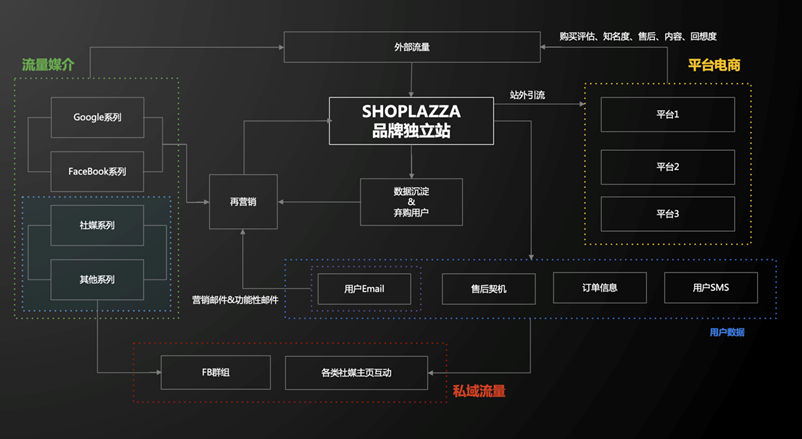
Dianjiang technology brand independent station private domain traffic operation diagram
Image credit: Shop Craftsman
In fact, consumers’ search actions when making purchase decisions, their actions to seek after-sales service on the official website, their active login to the website when looking for instructions for use, and even their dissatisfaction and complaints about products are the keys to the private domain conversion test of independent websites. node. Many people ignore these traffic because they are too few, but for a new business that has not been verified, these sporadic consumers can often provide guidance for the subsequent development of the project.
As can be seen from the above figure, through a variety of purchase buttons, users can decide whether to place an order on the official website or return to the shopping platform to place an order, bringing external traffic to the platform. In the early stage of the project, if there are suitable social media materials, the traffic of the social media platform can even be turned over through independent stations, and orders can be placed on the platform, forming a strong support for the platform business.
AlloyWorks is a very special one among the many Chinese overseas enterprises served by DianJiang Technology. It has outstanding performance in the field of automotive radiators in North America, but in the transformation, it is faced with how to consolidate its market position with low risk and high efficiency and deepen its "modification enthusiasts". This high stickiness group is the primary issue to meet the expansion of the product line.
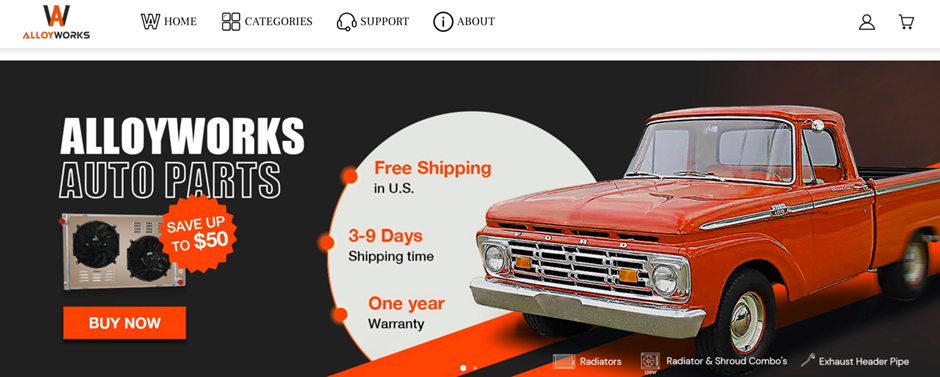
Image source: AlloyWorks official website
With the joint efforts of both parties, the new AlloyWorks brand site appeared as the brand's global official website. With the gradual improvement of the private domain conversion process on the site, the overall rate of return of the site has gradually increased and stabilized.
In the early stage, the independent station relied on the "after-sales traffic", "brand word traffic" and "consumer recall traffic" overflowing from the platform to conduct the private domain conversion test of the independent station, and thereby improve the conversion link of social media, KOL, and affiliate marketing. . In response to the return survey of these few customers, we found that it is more feasible to stand independently in the field of auto parts, and it is worth investing in a larger-scale traffic test. Subsequently, AlloyWorks decisively launched a large-scale advertising drainage, resulting in a large-scale increase in GMV. Finally, in the third quarter of the absolute off-season of this category in 2021, it is almost the same as the platform business volume, and good potential energy is formed.
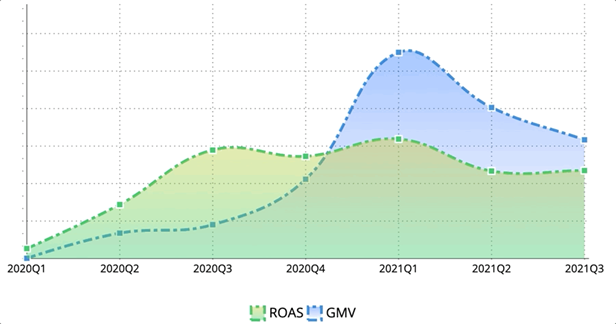
AlloyWorks 2020-2021 Q3 GMV & ROAS graph
Image source: Store Craftsman Data source: AlloyWorks Store Craftsman independent station background and advertising background statistics
The pipe is unblocked, and then turn on the faucet
The case of AlloyWorks is a good practice of the "limited brand" strategy, and the important methodology reflected is: for an enterprise with mature e-commerce operation experience, it can choose to give up the external "in the early stage of the transformation towards an independent brand station". Traffic media", relying on the overflow of "tap water" from the self-built traffic position to complete the private domain traffic conversion test in the initial stage of the brand station.
It's like setting up a water network system. Most people are worried about whether the quality of the pipeline is satisfactory and whether it can support the high pressure of the water flow. But more importantly, we first go through the right design and testing to make sure it's flowing in the right direction, unblocked, and not clogged. That is, make sure the pipes are unblocked first, and then turn on the faucet.
Florasis adopts a more stable traffic strategy overseas. In recent years, its marketing has been smooth sailing, and such brands have a similar understanding of going overseas from 0 to 1. As a cosmetics brand, Huaxizi has deployed almost all social media channels from the beginning of the North American station, but has been very conservative in converting traffic.
Unlike the medium-sized enterprise AlloyWorks, which relies on the "overflow" of platform traffic to slowly accumulate private domain traffic, as a brand mainly focused on female customers, it is a very stable choice for Huaxizi to start from social media in the early stage. As a female brand, the active performance of female groups in social media makes it, like all cosmetic brands, have a natural advantage in the field of social media communication; secondly, the influence of KOLs can boost the trust index of Huaxizi as a new brand in the hearts of consumers ; Finally, this is also a full test for the private domain conversion in the middle and late stages.
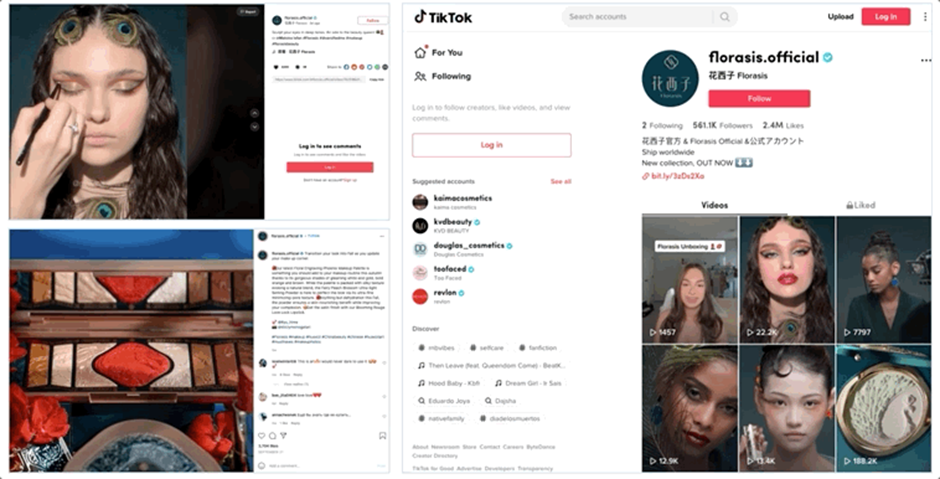
Huaxizi's overseas social media layout is very successful
Image source: Huaxizi's official social media homepage
As of the beginning of 2022, the search advertisements on the Huaxizi site are still dominated by brand words, which is very rare for a new brand with millions of traffic, because in many projects, everyone expects the expansion of brand word traffic, which means Absolute brand power and conversion rates.
The traditional branding method mainly focuses on conversion advertising and PR advertising in the early stage. Once the business is not smooth, the initial investment will become a sunk cost, which will bring huge pressure to the company , and Huaxizi's "social media first" strategy method is a good testing strategy. Compared with conversion advertising, the construction and maintenance of social media has a compound interest effect, and can form radiation on the domestic market and platform business, bringing practical effects.

Traffic Profile of Huaxizi US Site (Third Party Data)
Image & data source: similarweb
From the growth ideas of Huaxizi brand station, it is not difficult for us to draw the conclusion that "brand station ≠ advertising". Assuming that Huaxizi did not pass the foreshadowing of a large number of social media and KOLs in the early stage, but directly invested huge advertising costs, the result is conceivable. Even in China, before the large-scale advertising bombardment, in order to improve the efficiency of advertising, Huaxizi also built enough content online to improve the traffic conversion rate.
Therefore, if in the preliminary test, we find that our products, talents, and websites are not enough to convert even very weak traffic, please carefully consider "whether to change the business direction" to reduce the risk of business. This is also the solution to "risk and sunk costs" in the "limited brand" strategy.
"Differentiated Packaging" Helps SMEs Solve Cost Problems
Maybe not every company can copy the path of Huaxizi. Everyone may think that such brands have natural advantages in the supply chain, and their products have enough differentiation, at least it seems so. Small and medium-sized enterprises generally do not have such resources, and it is more difficult to pay enough costs to polish product differentiation.
But this is not necessarily the case, and "differentiated packaging" may be a solution. When it comes to product differentiation, I've always disagreed with the simple equation "differentiation = new features or new tooling." I firmly believe that what enterprises are facing is the contradiction between "corporate differentiated cognition and market demand", not the contradiction between "cost and demand".
In many cases, differentiation can be "packaged", perhaps in the appearance of the product. For example, the biggest selling point of shirts from US online clothing retailer UNTUCKit is that the shirt hem is relatively short.

Image credit: UNTUCKit
Perhaps it is the packaging of products like the US start-up brand LiquidDeath soda, which is the biggest selling point of the beer can-like packaging.
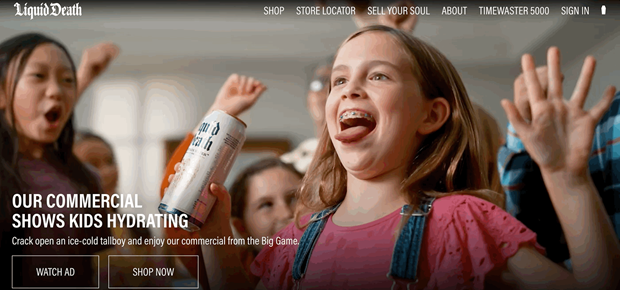
Image source: LiquidDeath official website
Maybe the product positioning is more innovative. For example, Exway, the world-renowned electric skateboard brand on the shopcraft platform, is also a brand from China. Its first product abandoned the boring parameters in the industry and designed an electric skateboard that is closer to ordinary skateboards. skateboard. As a result, the product received rave reviews as soon as it was launched, laying the foundation for the brand to go overseas.
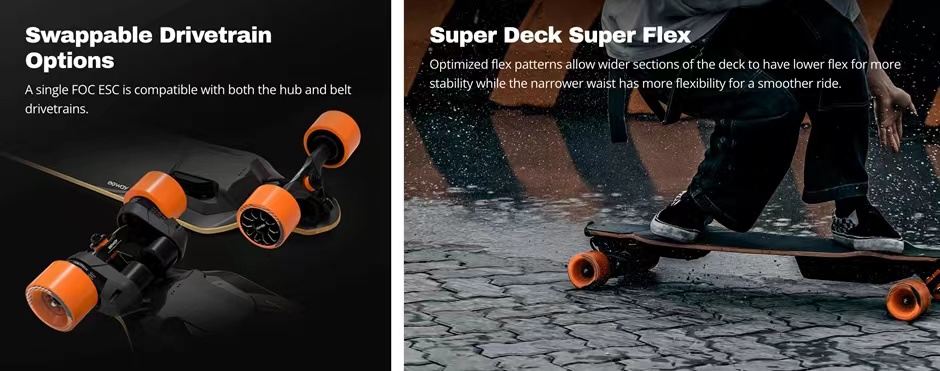
Image source: Exway official website
What's more, just being a better-looking model in a photo can make a difference.
And the case we will look at is from FIGS in the United States, to see how it can gain insight into emotional needs beyond data. Figs is a popular clothing brand in 2021. Founded in 2013, it has expanded its performance by 100 times in 3 years and will be listed in 2021. Its main product is "hand brushing clothing", which is the clothing worn by medical staff. Figures claims to have designed better-looking, colorful garments for healthcare workers, making them more polished and comfortable at work.

Image source: FIGS official website
It is difficult for us to imagine that there are companies that can achieve great success by relying on clothing design in the field of functional clothing with almost no design space.
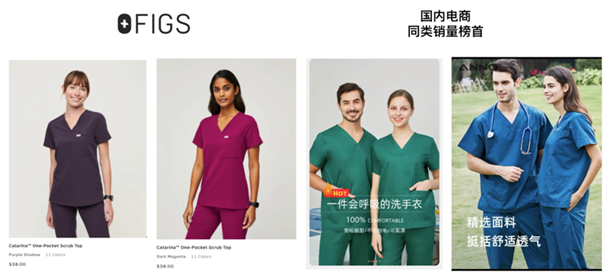
Comparison of the main picture of Figs product and the main picture of the top-selling product of the same kind in China
Image source: Screenshot of FIGS official website and domestic e-commerce platform
Searching for similar products on domestic e-commerce platforms, we can discover the power of FIGS. Maybe data will make brands ultimately successful, but in most cases, all we need is a pair of eyes for discovery. What Figs sells is not a certain clothing, but the emotional needs of a certain group. What these nurses, who have been overshadowed by the light of professional doctors, really need not color change or comfort, but a desire to be as popular and respected as sports stars. FIGS is only designed to meet this demand, so that the wearer can feel People's eyes are brighter. In the American market, this positioning and slogan will undoubtedly be very popular.
summary
Compared with the traditional business model of "building a website + advertising", the "limited brand" strategy, which is more refined and pays more attention to cost and risk assessment, may provide a brand new idea for brands:
- Take the independent station as a supplement to the business, not the transformation task of the enterprise
- Use a small amount of traffic overflowing the platform for private domain conversion testing
- After the user conversion process is verified, start the conversion ad test
This can be regarded as the "three axes" for the new brand to go overseas. It may not be an immediate strategy, but it does provide a feasibility for small and medium-sized cross-border enterprises that are seeking brand transformation.
"The hesitation of a tiger is not as good as the sting of a bee." We used to say "market maturity", but now all walks of life have far exceeded the word "maturity". If you're looking to take the first steps in your branding transformation, hopefully this article will clear that little bit of hurdle for you.
Read more in this Spotlight series
"Limited brand" strategy, a new DTC approach for small and medium-sized enterprises to go overseas
Chen Zhihao, shop craftsman
How can overseas brands seize social commerce opportunities and create "discovery moments"
WARC China

